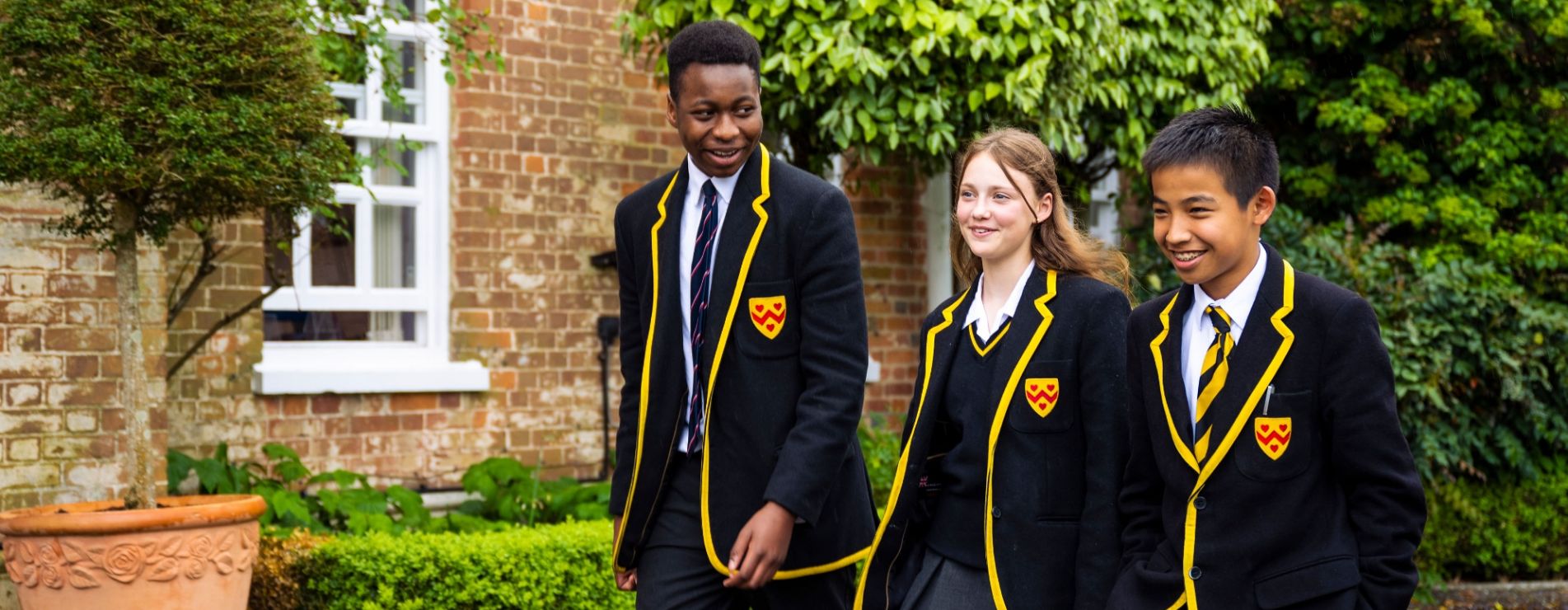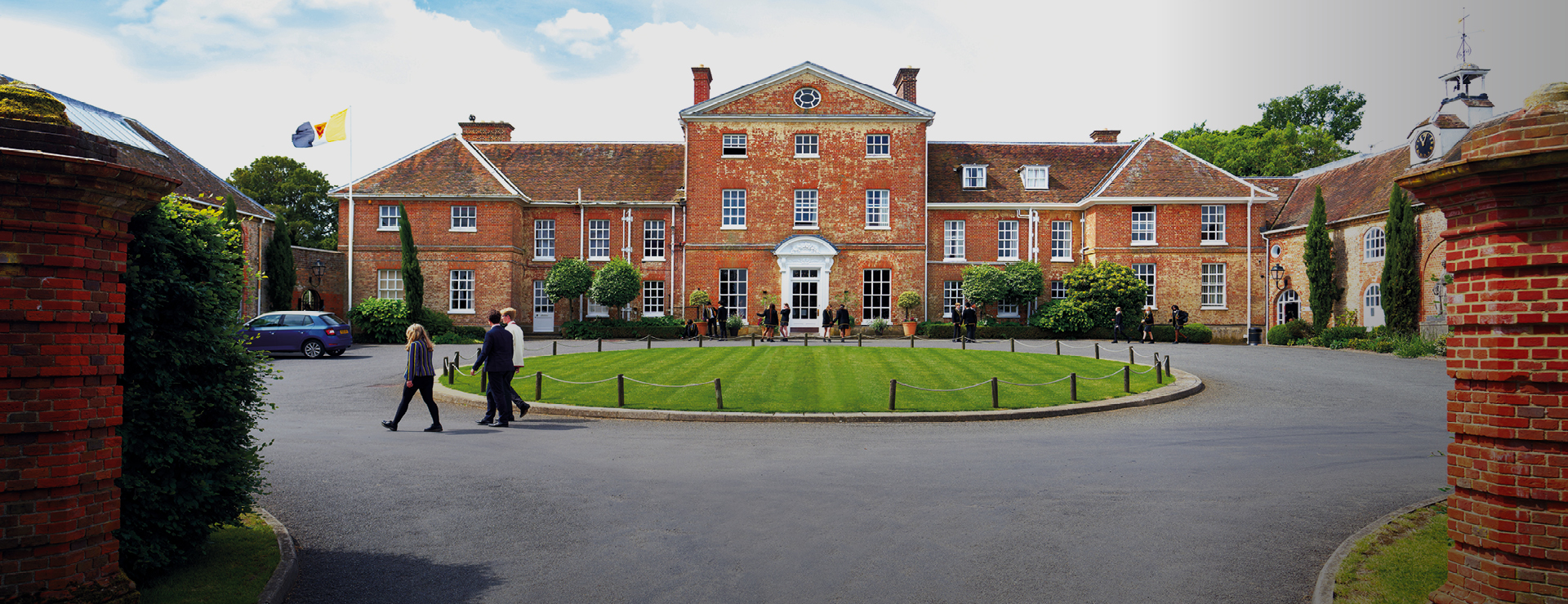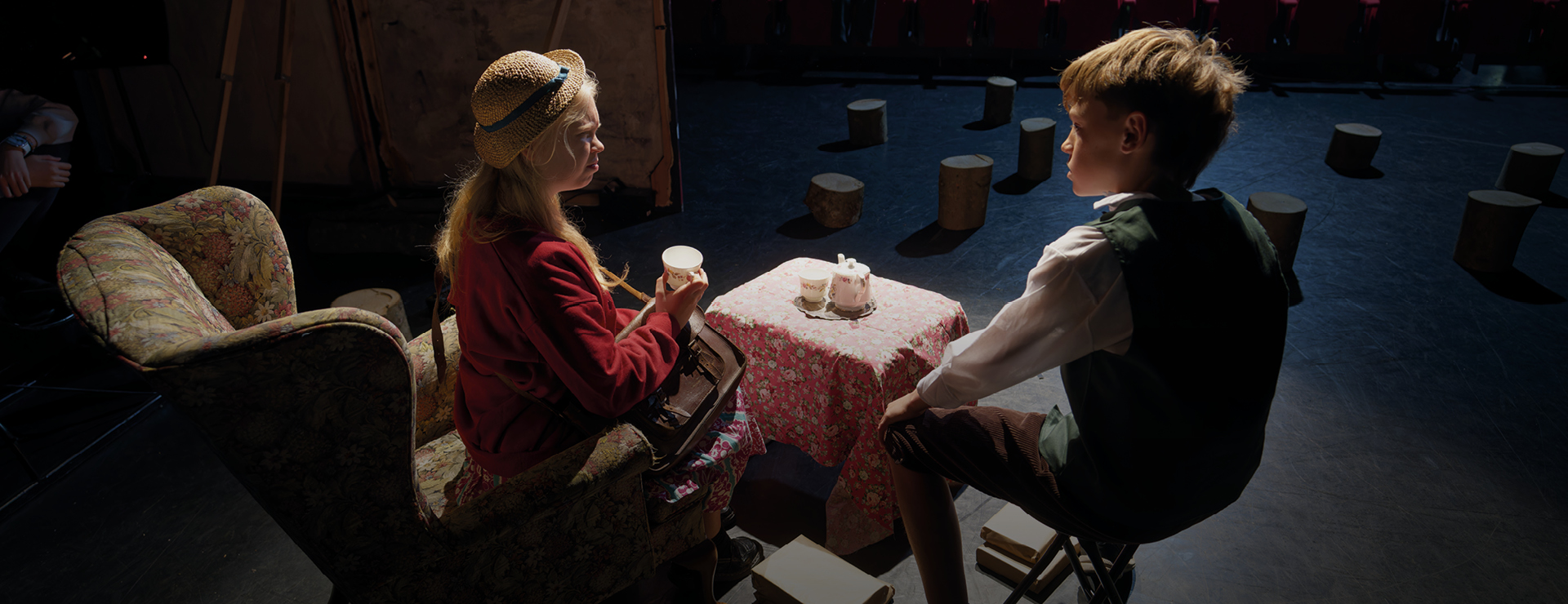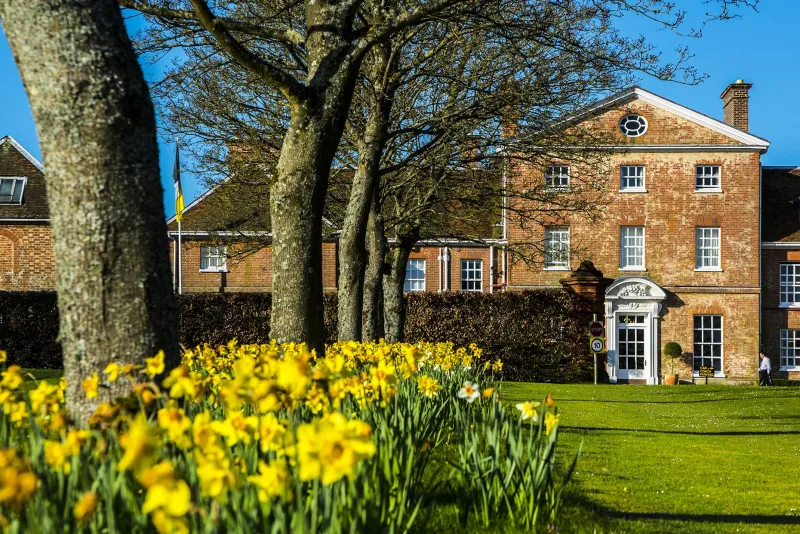History of The Oratory

Founded in 1859 by Saint John Henry Newman.
Saint John Henry Newman founded The Oratory School with the intention of providing boys with an alternative to the other Catholic establishments of the day. He had been very influential in the conversion to Catholicism of many formerly Anglican, middle-class, professional men. They now wanted him to educate their sons, giving them a liberal, classical education, which would fit them for universities and public life, but in a sound Catholic context. The Oratory School opened on 2 May 1859, with nine boys. The Head Master was to be the Oratorian priest, Fr Nicholas Darnell, and Newman appointed a Dame, Mrs Frances Wootten, imitating the great public schools.
Over the year the school steadily grew in numbers, in popularity, and in prestige. The sons of the old recusant families started to come, too. High-calibre lay staff were employed, schoolrooms built, playing fields rented, and extra-curricular activities thrived: all the trappings of an English public school were present by the late 1860s. In all things, however, the spiritual and religious life of the boys continued to be paramount.
Newman’s friend, Ambrose St John, took the helm, though Newman himself was often involved with the finances, the examinations, the annual Latin play, and the orchestra. He often wrote to, and had dealings with, the parents. After St John’s death, Fr John Norris and, in the early 20th Century, Fr Edward Pereira, were both outstanding Heads who made the school what it was: successful; Catholic; attractive to converts and old families alike. Boys went on to university, to Sandhurst and Woolwich, into Medicine and the Law. Many played a notable part in the Armed Forces, with 84 giving their lives in the Great War. Although Newman died in 1890, the school continued to be very much his school, still attached as it was to the Birmingham Oratory Fathers’ house, and with Fr Pereira, a former pupil of the Cardinals’ day, as Head Master.
In the early 1920s, a new site became necessary and the school was relocated to Caversham, just north of Reading. In this inter-war period, there were several changes of Head Master, a devastating fire, and national economic difficulties which, together with the removal from the historical Birmingham site, caused problems for the school. In 1941 the Caversham site was sold to the BBC and a new site was purchased in Woodcote, where the school remains to this day. Extensive building programs under Dom Adrian Morey OSB in the 1960s, Adrian Snow in the 1970s and 1980s, and latterly under Clive Dytor, gave the school hugely improved sporting facilities, classrooms, and new boarding houses. In 2020, under Joe Smith, the school became co-educational, welcoming girls alongside boys after 161 years of education.
Now with Mr Matthew Fogg as Head Master, Newman’s school continues to thrive with girls and boys
Our Founder
The Oratory is Saint John Henry Newman’s school. Newman was born in 1801, and was one of the foremost churchmen and theologians of his day. Learn more about our Founder here.
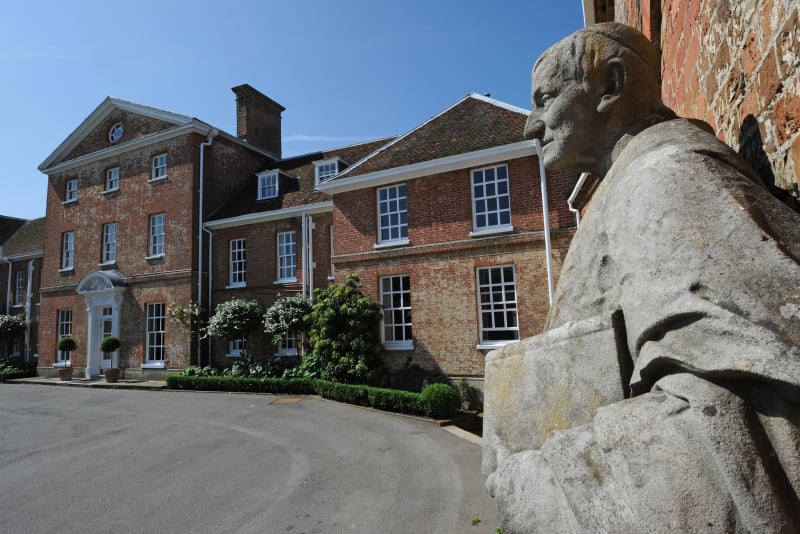
Explore key historic facts about The Oratory
Our Founder - Saint John Henry Newman
Saint John Henry Newman, born in 1801, was one of the foremost churchmen and theologians of his day. He studied and then taught at Oxford University, and became the Vicar of St Mary the Virgin, the University Church; he was known for his intellect, his pastoral care and his preaching. A leading light of the Oxford Movement which was seeking to move the Church of England in a Catholic direction, Newman left his considerable prospects, and many friends, behind when he converted to Catholicism in 1845 at a time when there was still widespread prejudice against Catholics in Britain. Founding the first Oratorian community of priests in Birmingham in the late 1840s, he continued to write major works of theology and philosophy as a Catholic. He founded a university for Catholics in Ireland and, in 1859, The Oratory School in Edgbaston, Birmingham. He was made a Cardinal in 1879 and he died in 1890. Pope Benedict XVI beatified him in 2010. Pope Francis canonised him on 13 October 2019. Pope Leo XIV made him a Doctor of the Church and co-patron of all things Education, alongside St Thomas Aquinas, on All Saints Day 2025.
Key facts:
- Born in 1801 to a middle-class London family and educated at a boarding school in Ealing.
- Religious background – Anglican.
- Had vivid religious experience at the age of fifteen and read religious works.
- Became an Evangelical.
- Went up to Trinity College, Oxford in October 1817. He had to subscribe to the Thirty Nine Articles of the Anglican Church.
- An academic high flyer, he was expected to get a double first, but barely scraped his final exams.
- Despite this, he got a Fellowship to the prestigious and intellectual Oriel College at Oxford University.
- Here he came under the influence of Keble and Froude, two High Churchmen.
- Newman had a profound influence on the undergraduates he taught at Oriel.
- Ordained to the priesthood in 1824.
- In 1828, he became Vicar of the University Church of St Mary the Virgin in Oxford, and became widely known for his preaching.
- His first book was Arians of the Fourth Century, published in 1833. It was at this time that he began to consider Protestantism as inadequate and to be interested in more Catholic teachings, for example, concerning the Virgin Mary and the Sacraments.
- He ministered to the poor parish of Littlemore, near Oxford, building them a new church and a school. He was already known for the holiness of his life and his compassion for the humble and needy.
- After a serious illness during a holiday in Sicily in 1833, he returned to England aware of a great work that lay ahead of him. He wrote Lead Kindly Light at this time.
- In the late 1830s, Newman became one of the leaders of The Oxford Movement, which supported the spread of Catholic teachings in the High Church party of the Church of England.
- He wrote many of the Movement’s Tracts for the times, including the famous Tract 90, written in 1841, which attempted to show that the Thirty-Nine Articles of the Anglican church were not opposed to Catholic doctrine. This received condemnation from almost all sides. He resigned from his position at the University Church.
- In 1841 he moved to a set of stables in Littlemore where he could study and pray. He was soon joined by friends including Ambrose St John.
- Between 1842 and 1845 he wrote one of his most famous works, An Essay on Development of Christian Doctrine. This showed how the Catholic Church was what she had always claimed to be: founded on the Apostles and unchanging in doctrine and sacraments from Christ onwards.
- In 1845 he decided to become a Catholic. He was received into the Catholic Church on 9 October 1845 by an Italian missionary priest, Blessed Dominic Barberi, at Littlemore.
- He and his Catholic companions were given a large house in Birmingham by the Catholic bishop and they moved to Maryvale.
- Newman and St John decided to offer themselves for the priesthood. They went to Rome to study and train, and in July 1847 were ordained.
- While in Rome, Newman learnt about St Philip Neri, the Founder of the Congregation of the Oratory. He decided that this model of priestly life was the right one for him and his companions – not monks, but living in community in cities to serve urban Catholics of all walks of life.
- On returning to England, he set up the first Oratory in the country in Birmingham, originally an old gin factory in Alcester Street, and then on the Hagley Rd in Edgbaston, where The Oratory fathers still live today.
- In the 1850s he spent much time on a project in Dublin to set up a Catholic University of Ireland. Catholic boys were not allowed to go to Oxford or Cambridge at that time. The money and support for this was not forthcoming and though there were some pupils and some buildings – notably the University Church – ultimately it failed. It was eventually absorbed into University College, Dublin (UCD).
- In 1859, Newman responded to a group of Catholic lay families in their request to start a school for their sons. The Oratory School opened in May 1859. Newman was very involved in the school, producing plays and playing in the orchestra, conducting oral exams, dealing with parents and money.
- In 1864 he wrote his most famous and accessible work, Apologia Pro Vita Sua. This was an explanation of his journey into the Catholic Church. It was very widely read and helped to change hostile attitudes towards him, though some, even within the Church, were suspicious.
- In 1879, the new Pope, Leo XIII made him a Cardinal (until this point he had been known as Dr Newman or Father Newman). Being made Cardinal was a great honour, and unusual in that he was not a Bishop and did not have to go and live in Rome. This showed that his life and work were recognised by the Church.
- Newman was now permitted a coat of arms and a motto, Cor ad Cor Loquitur, was taken from the writings of St Francis de Sales and summed up Newman’s approach to relations between God and Man, the nature of belief, the spiritual life, education and friendship.
- Still writing, preaching and still involved with the school into his eighties, Newman died in 1890 at the age of 89.
- His memorial epitaph (which he had written himself some years earlier), is Out of the Shadows and Images and into the Truth.
- He was buried in the same grave as his friend, Ambrose St John, in Rednal, until he was exhumed in 2009 in preparation for his beatification.
- His remains are now in the Oratory church in Birmingham.
- He was canonised by Pope Francis as Saint John Henry Newman on 13 October 2019.
- His feast day is celebrated on 9 October, which marks the anniversary of his conversion to Catholicism, rather than the date of his death. This decision reflects a unique tradition within the Church, as feast days are typically celebrated on 'dies natalis' (day of death) of saints,
- On All Saints Day 2025, Pope Leo XIV made him a Doctor of the Church and co-patron saint of Education, alongside St Thomas Aquinas.
The Oratory School
The Oratory School was founded in 1859 in Edgbaston, Birmingham, by Saint John Henry Newman, and was situated next door to the house of the Oratory Fathers on the Hagley Road. Newman’s convert friends who had themselves been to one of the public schools, asked him to found a school which their sons could go to: Catholic schools, but giving a broader education than the existing junior seminaries, and fitting them for university and then professional and public life. The school opened its doors to nine boys at the beginning of May 1859. Since that time, the school has grown and, has moved twice, firstly to Caversham Park in 1922, and then to Woodcote in 1942. The Oratory had always been largely staffed by laymen, Newman’s vision for an educated laity found its expression in his Oratory School.
Key facts:
- Founded by Saint John Henry Newman, the most famous English Catholic convert of the 19th century and one of the greatest thinkers and writers of his time.
- Founded in 1859, opened its doors on 1st May to nine boys.
- Within two years there were over sixty boys in the school.
- Initially in Edgbaston, then a leafy suburb of Birmingham, close to The Oratory Church and house of the Oratory Fathers, at 97 Hagley Road.
- Founded at the request of a group of converts to Catholicism, who wanted to send their own sons to a Catholic school run on public school lines
- Newman had written his great educational work, The Idea of a University, in 1852, in relation to his Catholic University of Ireland. The Oratory School became the living example of his ideas at school level.
- The first Head Master was Fr Nicholas Darnell, though Newman was always in close contact with the school. The school was very much his project and parents trusted him to educate their sons.
- The school, uniquely for Catholic schools at the time, had a Dame, Frances Wootten, a woman friend of Newman’s from his Oxford days.
- The school was to be for “the education of boys not destined for the ecclesiastical state and not above twelve-years-old on their admission."
- The curriculum was to be that of an English public school like Winchester – many of the first masters had been there – a liberal education studying not only the classics, but history, science, maths and geography, with the added dimension of Catholic teaching.
- The Oratory School is the only surviving institution which Newman founded, apart from the Birmingham Oratory itself and University College Dublin. We have an unbroken line of succession from his day to ours.
Celebrating our 160th Anniversary
2019 was an exciting year for The Oratory School as it became 160 years since the school was founded by Saint John Henry Newman in Edgbaston, Birmingham.
The school began on 2 May 1859 with 9 boys. Since that time, the school has moved twice, firstly to Caversham Park in 1922, and then to Woodcote in 1942 and has grown in size since its Victorian days of no more than 70 boys.
Today we will reflect on all that the school and its pupils have achieved, and celebrate everything that makes the school so special: our wonderful pupils and talented teachers, our supportive parents, our passion for education, our nurturing Catholic values and our beautiful expansive grounds.
Key Facts
- Founded in Edgbaston in 1859.
- For the first 100 years, virtually all boarders were Catholics, a small number of them European aristocrats.
- The first Head Master, Fr Darnell, resigned after eighteen months and was replaced by Fr Ambrose St John.
- Boys lived in houses on the Hagley Road and had a schoolroom, a chapel and a gym next to The Oratory fathers’ house. Dame Wootten and Edward Ransford – a tutor – lived at number 97 with the boys.
- The school acquired sports fields as well as the land behind The Oratory where games were played.
- There were never more than about 80 until after the Second World War,
- Staff were a mixture of Oratorians and lay staff – mainly the latter, which was unusual in a Catholic school in the 19th Century.
- Subsequent Head Masters include Fr John Norris Cong Orat (Head 1872-1911) and Fr Edward Pereira Cong Orat (Head 1911-21 and 1922-29).
- The CCF was founded in 1913.
- Over 400 Old Oratorians served in the Great War and 84 gave their lives.
- The Oratory School moved site to Caversham in 1922, taking over the buildings and grounds of Caversham Park.
- In 1925, The Oratory Prep School (OPS) opened with four pupils at Rose Hill in Emmer Green, near Reading,
- In 1938, The OPS moved back into the Caversham Park site.
- In 1926, the annual cricket match against Beaumont was accorded the honour of being played at Lord’s for the first time.
- Also in 1926, an extensive fire severely damaged the school buildings.
- In 1941, with financial troubles and low numbers, the school decided to sell Caversham Park. The school went to lodge temporarily at Downside until suitable premises could be found.
- The first lay Head Master was Gerard “Bones” Headlam (HM 1938-42).
- In May 1942, the school opened in Woodcote.
- The OPS was re-founded in 1946 at Branksome in Bournemouth.
- In 1969, The OPS moved to Great Oaks, Goring Heath, where in 1970, a Pre-Prep department was opened.
- At The Oratory School, new boys at thirteen lived in a separate house – Junior House – in Exlade Street.
- In 1943, the priest who had been School Chaplain at Caversham, Mgr George Tomlinson, became Head Master (HM 1943-53). He and Dom Adrian Morey OSB (HM 1953-67) laid the foundations of the modern-day Oratory School.
- In 1954, the school reached 100 pupils again, the first time since the best days at Caversham.
- Dom Adrian Morey built what is now the Art and Languages block (the Tomlinson building), and the science and classroom block (the Morey building). He built a new Refectory, now the Library, a swimming pool and a squash court.
- In 1959, the school numbers reached 200 for the first time. Dom Adrian became a member of HMC in 1962.
- In 2020, the school became co-educational, educating girls alongside boys for the first time.
- Notable recent Head Masters include:
- Adrian Snow (HM 1972-88) who built St John, the Chapel and Refectory block, and St Philip House (The Junior Department as it was called then). He also oversaw the terracing of the front of the school and the Sports Hall. Numbers grew to over 400 boys during his time.
- Clive Dytor (HM 2000-2015) who oversaw the building of two new boarding houses, the conversion of the Morey building for academic departments, and the renovation of the swimming pool.
- Joe Smith (HM 2017-2023) who oversaw the schools' successful move to co-education after 161 years of being an all boys' school.

